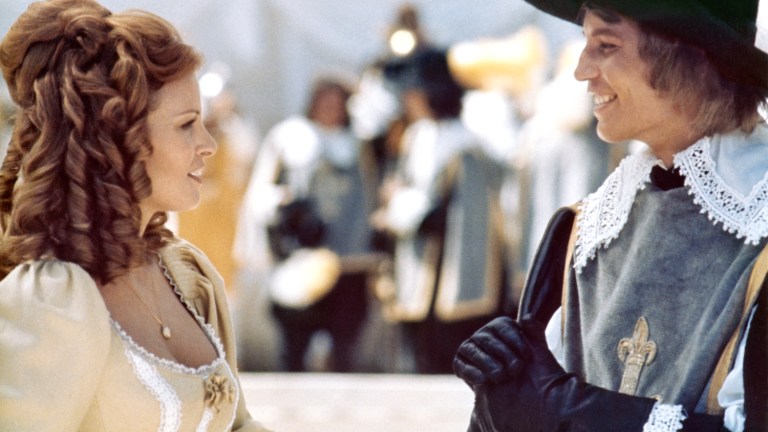Remembering When Raquel Welch Elevated The Three Musketeers
The late actress and reluctant sex symbol, Raquel Welch, brought something to The Three Musketeers that even Alexandre Dumas missed: comic timing.

Later in life, Raquel Welch would occasionally acknowledge that Richard Lester’s The Three Musketeers (1973) and The Four Musketeers (1974) provided her with the best reviews of her career. And it’s hard to argue. Prior to those successful, and slyly subversive, reworkings of Alexandre Dumas’ most famous novel, Welch was known as the sex symbol of the ’60s. She was the redhead in the fur bikini of One Million Years B.C. (1966); the poster image that was so iconic her figure became the primary sales pitch for a movie about dinosaurs!
The bombshell persona opened the doors of Hollywood, but for a woman who was already a mother of two at the time and had to change her name to hide her Bolivian heritage, it was a mirage. She ran with it throughout the ‘60s, leaving a legacy that lingered on in movies which ranged from The Shawshank Redemption (1994) to Belfast (2021). But it wasn’t the sum of her potential or talent, a fact that obituary writers are grappling with this week following the news that Welch passed away at the age of 82.
It’s also what made Lester’s Three Musketeers adaptation such a highlight in her career—and perhaps a promise of potential that was never fully realized.
In both Musketeers films, Welch portrayed Constance Bonacieux, the wife of a landlord who bedevils the young hero D’Artagnan (Michael York). As with the 1844 Dumas novel that inspired the films, Constance is the young wife of an old man and is in need of rescuing and romancing by the hero (Dumas was French). Yet on the screen, she was more than the hapless love interest… even if Welch’s Constance was definitely hapless.
Essentially one of the film’s many comic side characters, Lester and Welch’s Constance is a snakebite klutz who couldn’t get out of the way of her own rescue. Seriously, there’s a scene in The Four Musketeers where the original three swashbucklers come to her aid, and Constance assumes they are more guards of the villainous Cardinal Richelieu (Charlton Heston). So she swiftly kicks two of them in the crown jewels. As filmed in a wide, objectively disinterested shot, the moment relies on the most base of physical comedy, and yet achieves the kind of understated visual deadpan Lester pioneered in movies like the the Beatles films A Hard Day’s Night (1964) and Help! (1965)—arguably forerunners to Monty Python’s more anarchic sensibility in cinemas a few years later.
The droll silliness of the scene is a result of Lester’s natural sensibility, but it also relied on excellent comic timing from each actor, including Welch whose Constance is required to fall down and be the butt of the joke in nearly every scene of the movie she appears. She’s like a bombshell version of Margaret Dumont in a Marx Brothers joint, including when she nervously blocks the eyes of Porthos (Frank Finlay) as he carries her away from the danger on his back via giant stilts.
It’s all disarmingly funny, yet even this comic spectacle belies the importance of casting the right kind of talent. For instance, the following scene in which Constance rides on Porthos’ back alongside the other three Musketeers, galavanting away from danger, is a cinematic illusion. In real life, Welch was the best horse rider of the group, and she took the reins from behind to control the horse when Finlay couldn’t. She might be the comic relief, yet she is literally driving the shot.
In this way, Welch contributed considerably to the appeal of Lester’s Musketeers duology. When taken purely as a narrative rendering of Dumas’ gargantuan novel, the two movies are the most faithful adaptation of the source material. The stakes for most of the story are rarely higher than recovering the jewels of Queen Anne (Geraldine Chaplin), for whom Constance is a dressmaker and confidant. The Musketeers hope to prevent embarrassment for Anne and France due to her affair with the Duke of Buckingham (Simon Ward). The mission also acts as a way to prevent Cardinal Richelieu from starting (and then elongating) a war with England. Yet for the musketeers, that’s almost happenstance. These are simply proud swashbuckling heroes doing their duty.
Onscreen, however, they’re also presented as a bunch of schmucks serving entitled fools. Lester’s Queen Anne is sympathetic and more deserving of loyalty than her buffoonish husband, King Louis XIII (Jean-Pierre Cassel), but she is still putting the lives of the musketeers and even Constance in mortal danger. Meanwhile her true love, the Duke of Buckingham, is carrying on his own affairs on the side despite preparing to wage war with France to steal Anne. In the middle of it all, the only musketeer seemingly aware of the utter meaninglessness of the bloodshed is Athos (Oliver Reed), a mean drunk and perhaps the most noble man in the lot because he’ll still raise the sword out of honor between cups.
Welch’s Constance is reworked to serve this vision too. Partially, this is done to update the material for the frothier tastes of post-1960s audiences. While D’Artagnan and Constance have an unrequited affair between their hearts on the page, within 10 minutes of appearing together in the movie, York’s boyish hero and the pretty wife of his decrepit old landlord (Spike Milligan) are happily falling into bed together.
However, even the sexier and more playful tone underscores why so much of Lester’s version is a satire of honorable codes of conduct, and the battles the poor fight for the rich. Like in the book, Constance is the one real casualty of these adventures. At the end of The Four Musketeers, she is brutally strangled to death with her own rosary by the sinister Milady (Faye Dunaway), who coldly slaughters Constance to get revenge against D’Artagnan. The young man bedded and used the femme fatale, whose pride always demands she be the exploiter. So in Milady’s mind, Constance, the cheerful klutz whose bodice the camera salivates after, becomes the ideal sacrifice for these empty war games.
It’s the bitter tragedy at the heart of Lester’s vision of this tale about charmingly clueless fools in snazzy tunics. And it’s to Welch’s credit that she perhaps recognized this before the director did.
Indeed, the actress famously turned down the role of Constance after first reading the script for The Three Musketeers. Not one to take no for an answer, Lester then called her up and got the actress to agree to fly out to Spain where filming would soon commence.
As Welch told Dick Cavett at Lincoln Center, “I said to Dick [Lester] on the telephone, ‘Why does she fall down?’ And he says to me these words: ‘There is no reason.’” Up until that point, even Lester viewed Constance as little more than the eye candy who does “nothing.” Once in Spain though, Welch took Lester to lunch and asked to drill into what the character could be. Lester came to the idea of looking at the “old silent screen stars and those wonderful comedies.” He told Welch to think of Buster Keaton. Given how she actually portrayed the character though, he might’ve been better off naming Lou Costello.
Either way, along with the whimsical sword fights, Reed’s brooding glower, and Dunaway’s icy menace, it is Welch’s physical comedy which immediately caught audiences and critics’ attention 50 years ago. According to Quentin Tarantino, who still calls the picture one of his favorite movies, the ending sequence of the first film—where the four heroes, plus Constance, walk triumphantly away from a tournament, only for a jousting dummy to knock Welch over—“brought the house down.” Tarantino continued, “You’re still laughing during the end credits… I love that little image of Richard Chamberlain stifling his laugh. It’s one of his best moments in the whole movie, his laughing at Raquel Welch’s fucking clumsiness.”
It was enough to even win Welch a Golden Globe for the Best Actress in a Musical/Comedy that year—perhaps a bit incredulously since it was the same 12-month period that gave us Chloris Leachman in Young Frankenstein (who was nominated) and Madeline Kahn in Blazing Saddles (who wasn’t). But that is how much audiences were taken with the performance. It was a crowning moment for Welch, who by asking the simple question of “why does she fall down?” elevated one of the best swashbucklers in film history.
